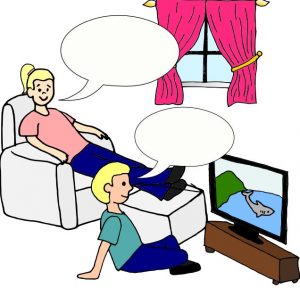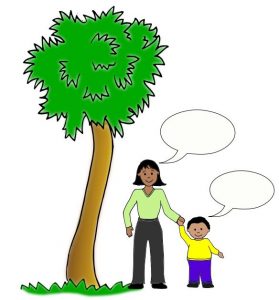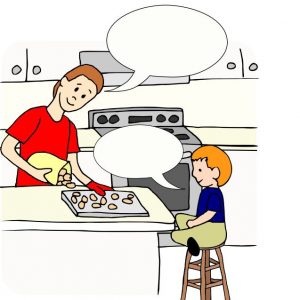 As we are spending so much time at home, we are facing the dilemma of how to keep our children entertained. Thoughts of children sitting in front of a screen while many parents are still trying to get some work done dredges up mixed feelings. At least they’ll be entertained and kept out of mischief, but we know that too much TV cannot be a good thing. But TV does not have to be only negative. Television (with controlled and limited screen time) can be part of a balanced program for kids. You can actually support your child’s language skills when you watch TV or movies together! Keep reading below or click here to download a handout on supporting your child’s language when watching TV or movies and handouts for other activities.
As we are spending so much time at home, we are facing the dilemma of how to keep our children entertained. Thoughts of children sitting in front of a screen while many parents are still trying to get some work done dredges up mixed feelings. At least they’ll be entertained and kept out of mischief, but we know that too much TV cannot be a good thing. But TV does not have to be only negative. Television (with controlled and limited screen time) can be part of a balanced program for kids. You can actually support your child’s language skills when you watch TV or movies together! Keep reading below or click here to download a handout on supporting your child’s language when watching TV or movies and handouts for other activities.
Category: Everyday activities
 Your child’s teacher and school librarian always encourage reading books at home. Keep reading below or click here to download a handout on supporting your child’s language when reading and exploring books and handouts for other activities.
Your child’s teacher and school librarian always encourage reading books at home. Keep reading below or click here to download a handout on supporting your child’s language when reading and exploring books and handouts for other activities.
WHY is reading and exploring books so important for promoting language and literacy development?
- Children need to hear many words often. Reading to your child often exposes them to more words and builds his/her vocabulary.
- Children learn words when they are interested. Books motivate children to communicate and, when parents respond to what the child is interested in, it helps the child learn new words.
- Reading builds vocabulary and meaning. Children learn what words mean when parents read with them and explain what new words mean while pointing to the pictures.
- Vocabulary and grammar are learned together. Children need to hear new words in grammatically correct sentences in order to learn language efficiently. Reading books with your child exposes them to new words used in grammatical sentences.
- Positive, extended conversations support cognitive and social development. When parents read with their child this promotes a positive interaction and shared conversation.
 You can support your child’s language skills when playing inside on rainy days, or whenever your child needs to take a movement or brain break to play! You can download a handout on supporting your child’s language skills when playing inside and handouts for other activities here.
You can support your child’s language skills when playing inside on rainy days, or whenever your child needs to take a movement or brain break to play! You can download a handout on supporting your child’s language skills when playing inside and handouts for other activities here.
 While keeping a safe physical distance from others, you can support your child’s language skills when playing outside. You can download a handout on supporting your child’s language skills when playing outside and handouts for other activities here.
While keeping a safe physical distance from others, you can support your child’s language skills when playing outside. You can download a handout on supporting your child’s language skills when playing outside and handouts for other activities here.
 During this unprecented time of social distancing, many of us are eating at home with our families more than before. Cooking together is a wonderful way to work on language goals with your child! Narrate as you plan and cook together. This provides a language model for your child and is a great way to introduce new vocabulary and grammar. For example, “First I am mixing in the eggs, then I will mix in the milk”. Remember to speak in the first person instead of referring to yourself as Mommy/Daddy (e.g., use “I am mixing in the eggs.” instead of “Mommy is mixing in the eggs.”). Meals are also a great time to sit and practice language in a relaxed way. You can download a handout on Supporting Your Child’s Language Skills when Cooking and Sharing Meals and handouts for other activities here.
During this unprecented time of social distancing, many of us are eating at home with our families more than before. Cooking together is a wonderful way to work on language goals with your child! Narrate as you plan and cook together. This provides a language model for your child and is a great way to introduce new vocabulary and grammar. For example, “First I am mixing in the eggs, then I will mix in the milk”. Remember to speak in the first person instead of referring to yourself as Mommy/Daddy (e.g., use “I am mixing in the eggs.” instead of “Mommy is mixing in the eggs.”). Meals are also a great time to sit and practice language in a relaxed way. You can download a handout on Supporting Your Child’s Language Skills when Cooking and Sharing Meals and handouts for other activities here.
Cooking Activities and Strategies
- Before you begin, brainstorm what you want to make, and create a list (written or drawn) of the ingredients you’ll need.
- Flip through a recipe book together or look online. If your child struggles with reading, you can draw a sketch of ingredients and steps. Some food bloggers show photos not just of the finished product, but of each step of the recipe. Many children with language difficulties will appreciate having this visual support.
- Discuss the recipe together before starting. Talk about what you will do first, next, then, or last.
- Talk about where to find the ingredients and utensils needed (e.g. “The mixing bowl is in the drawer.” or “The drawer is under the microwave.”).
- Practice and talk about taking turns when adding ingredients, mixing, etc. Use phrases such as: “Whose turn is it?”, “It’s your turn now.”, “It’s your brother’s turn now”.
- Develop vocabulary by not only labeling objects (e.g., pasta, water, spoon), but also demonstrating action words (e.g., slice, pour, stir), and descriptive words (e.g., slowly, soft, sharp).
- Practice asking and answering wh-questions (e.g. “What do we need next?”, “Where is the bread?”, or “When do we add the salt?”).
- Talk about the quantities of the ingredients you’re using (e.g., “We need more carrots.”) and how they relate to each other (e.g., “This tomato is big, and this one is bigger”).
- Practice understanding and remembering directions. Some children will need short directions (e.g., “Put the lettuce in the bowl.”), and others are ready to work on longer ones (e.g., “Put the lettuce in the bowl, then go get a cucumber and wash it.”). Discuss strategies we use to help us remember and show we understand, such as repeating back what we hear, paraphrasing what we hear, or writing or drawing the information.